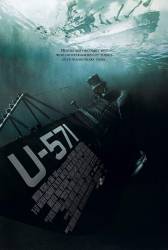Factual error: At the beginning of the film the German commander is shown directing an attack using the periscope in the control room. German U-boats had two periscopes: a 'sky' scope (the one in the control room) used exclusively for searching the area directly above the boat prior to surfacing, and the 'attack' periscope located in the conning tower (turm). There'd be no sense in the commander using the sky scope - the attack scope had an integrated firing switch, much more stable view, smaller outline over water and better magnification. (00:03:00)
Factual error: At the beginning of the movie, the German sub gets surprised and severely damaged by a destroyer. The sonar man first notices the enemy destroyer approaching, but only a short time before the destroyer is already literally on top of the sub. German sonar at the time had the capacity to detect ships up to more than 7 miles away. (00:03:40)
Suggested correction: He was in the sound room, not running sonar...given they were attacking a convoy, they wouldn't be running soar as that could be picked up by other ships.
That is not correct. The German U-boat is literally running passive sonar and detecting the destroyer with that. Active sonar, using a 'ping' sound that could be picked up by other ships, was rarely, if ever, used by German U-boats at all.
Factual error: At the beginning of the film the depth charge attack is shown rupturing a diesel fuel line in the engine room, which showers the fuel DOWN on the crew stationed there. In fact the fuel lines ran UNDER the deck plates and so a broken line could not shower fuel in that manner. (00:05:55)
Factual error: Depth charges explode at a distance of some 10 meters from the boat without any fatal effect. In reality fatal (i.e. destroying) distance was some 50 meters. (00:06:00)
Suggested correction: The second sentence is in error. Hull-rupture maximum distance is approximately FIVE meters. K-gun DISPERSION range was selectable from the attacking DD or DE: (1) Mk-6 at 50, 75, and 120 yards, (2) Mk-9 at 60, 90, and 150 yards.Citation:http://uboat.net/allies/technical/depth_charges.htm states "The pressure hull of the U-boat was strong enough to withstand anything but a charge exploding 10 or 20 feet from its hull.", and http://www.math.iitb.ac.in/~manishk/msc_project/OR-Notes-Mirror/OR-Notes/mscmga.ms.ic.ac.uk/jeb/or/intro.html states "As mentioned above the standard 250lb depth charge was believed to have a lethal radius of only 5-6 metres."
I have seen German sources which suggest any depth charge going off closer than 100 meters would be instantly deadly. I don't know where those sites you cite get their info from, but descriptions of battles from the era of from a submariner's perspective make it look extremely unlikely that bombs of the stats which you describe would have been an effective weapon at all.
100 metres is 330ft. If depth charges were that effective, the Battle of the Atlantic would have been won in days. Escort ships used to drop ten charges in a pattern to sandwich the sub when they exploded.
Factual error: At the beginning of the film the diesel fuel in the German U-boat is shown being ignited by a spark and bursting into flames during the depth charge attack as if it were gasoline. In reality diesel fuel is quite hard to ignite when not compressed and does not burn quite so readily as shown in the film. (00:06:05)
Factual error: At the beginning of the movie, the German commander wants to send an emergency message with coordinates to the BdU, the German Submarine Command, to send help. The scene is subtitled in English with "To Berlin: Location 85-32." However, the command post at the time was based in Lorient, France and not in Berlin. (00:08:05)
Suggested correction: He didn't send the message to the BdU, his message was send to the OKM (OberKommando der Marine), which had its headquarters in Berlin, because it involved the enigma code (although the movie is only loosely based on historic events). These kinds of messages were always send to Berlin. This is because the OKM answered to the OKH, which in turn answered to Hitler who was of course also in Berlin. This is their concern, not that of the BdU.
Of course he does, the commander literally says to the radioman "Ruf an BdU absetzen: Position AL 85-32. Alle Maschinen ausgefallen, manövrierunfähig, erwarten Hilfe" or "Send transmission to BdU: Position AL 85-32. All engines out of service, unable to manoeuvre, we expect help." This was correct procedure, proper chain of command would always be to contact the BdU, not the OKM. Also the integrity of the enigma was probably not a concern at that time, the crew would have ample time to destroy all sensitive materials if they were in danger. The German commander's main concern was to get his sub back up and running.
Right, I couldn't understand that part before. But you are right.
Continuity mistake: At the very beginning U571 is being depth charged and forced to surface but the attacking destroyer has disappeared. (00:08:20)
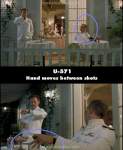
Continuity mistake: When Tyler is out on the deck, he has his hand raised. When the "boat secure" order is shouted it's now lowered and holding on to his glass. (00:12:10)
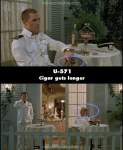
Continuity mistake: In the start of the film Matthew McConaughey is sitting on a porch at a wedding reception smoking a cigar, in one shot he has a stub left then in the next it's a new one. (00:12:20)
Factual error: The yard set has a red and white stop sign. Stop signs during WWII were yellow with black letters. (00:12:30)
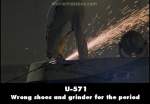
Factual error: In the ship yard after the party, one of the navy crew is working on a sub and he is using a yellow plastic handled grinder. All tools in this era were metal handled. He's also wearing tennis shoes. (00:13:15)
Visible crew/equipment: When they are first reporting to the dockyard in the beginning, right after being waved through the gate, there are servicemen working on the ships. In one of the shots, a serviceman making sparks with a grinder for effect is wearing a white Adidas shoe on his left foot, with the logo fully visible on the heel. This is in the BluRay edition. (00:13:17)
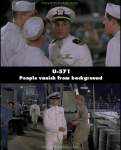
Continuity mistake: Tyler states he doesn't know what's going on to a few seamen and tells them to do their jobs. As the shot changes the seamen have all disappeared from the background. (00:14:50)
Factual error: When the marine commando shows the sailor his "luggage" (the boxes of explosives) to be loaded onto the submarine, some of the boxes have orange Explosive B placards. Those are Dept. of Transportation placards. The D.O.T. didn't exist until 1966 and the placards were not used until later than that. (00:19:55)
Continuity mistake: As the submarine is preparing to leave the dock in one of the movie's first scenes, Bill Paxton, the commander is standing on the top part of the sub. A seaman is walking in Bill Paxton's direction and the camera is at a distance. As the camera zooms in the man walking should have been in the frame under Mr. Paxton but he just disappeared. (00:20:20)
Visible crew/equipment: Just as the SS-33 sets off we see the crew on board say "all ahead two thirds". As they say this the camera moves behind a ladder resulting in a camera shadow on the ladder. (00:20:50)
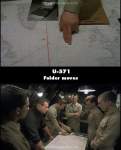
Continuity mistake: During the mission briefing, the position of the Top Secret folder changes from the centre of the map to the side of the map between instant cuts. (00:23:30)
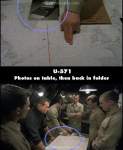
Continuity mistake: During the first mission briefing, the commander is pointing to the map and you can clearly see the top secret photos of the enigma sitting by the manila envelope, but right after that shot he pulls the photos out of the envelope and hands them to people. (00:24:20)
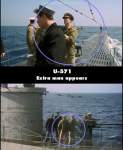
Continuity mistake: Just after unveiling the Nazi plates on the SS-33, there are 3 seamen wearing brown jackets next to the deck gun. When the shot changes there are 4. (00:25:00)
Other mistake: As the Germans open fire on the British sailors in a life boat, there is a panning shot of the crew. In this shot, a hair (or scratch) that made its way onto the film itself is visible on screen. (00:27:20)
